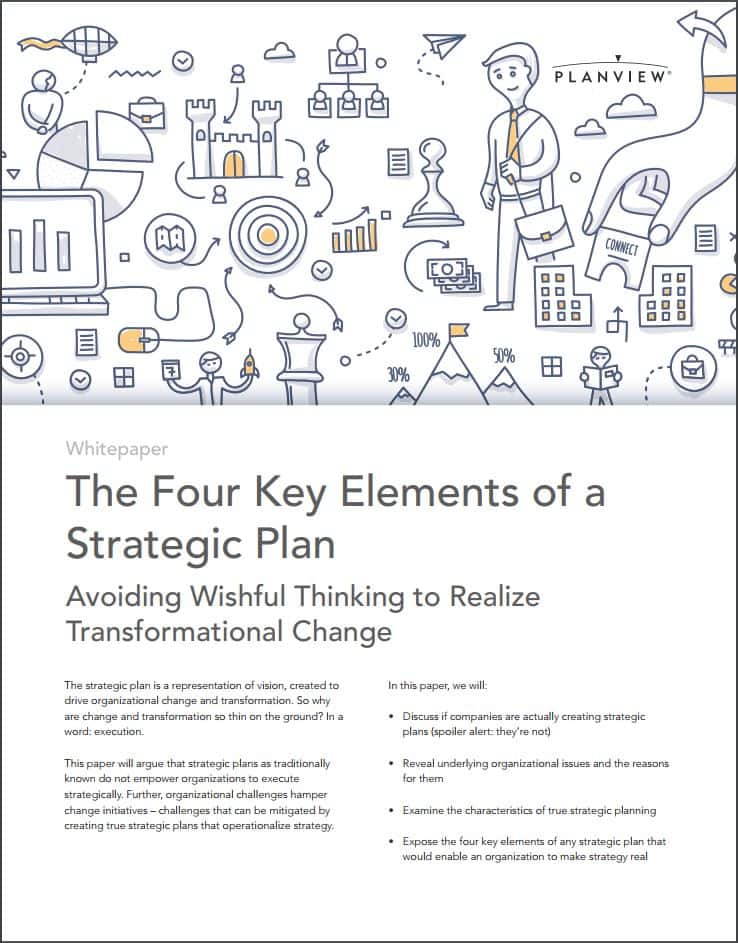
Does it seem that your company strategic plan is a lot like any well-intentioned lifestyle change? It’s great on paper, but the minute real life interferes, the fitness routine and clean eating goes out the window.
Your enterprise wants to drive a vision of change and transformation—that’s what the strategic plan is all about. The hard part is actually executing on it. Disruptions are everywhere—from people to competitor surprises to supply chain upsets. In fact, experts say 50% of your company strategic plan will likely come to naught. Even more frustrating is that, everyone on your team is heads down, working hard, while the plan fails to live up to expectations.
Isn’t it time to tackle the underlying issues that keep your business from a strategic plan that truly operationalizes strategy? In a new whitepaper, The Four Key Elements of a Strategic Plan, we take an in-depth look at how leaders can drive real change. And no, it’s not just more wishful thinking!
First, let’s admit how badly we are failing. The first hint is that it’s in the name. Maybe what we have been passing off as a “plan”  is really more of a “strategic statement.” Consider these startling statistics about leadership visibility into strategic planning from a Harvard Business Review report, “Why Strategy Execution Unravels—and What to Do About It”:
is really more of a “strategic statement.” Consider these startling statistics about leadership visibility into strategic planning from a Harvard Business Review report, “Why Strategy Execution Unravels—and What to Do About It”:
- 33% of executives could name just two of their company’s strategic priorities
- 55% of managers could name only one
- Just over 50% of CxOs understood how major priorities connect to strategic initiatives
- Fewer than 33% of their direct reports got this
- Only 16% of team leads—those responsible for execution—understood this
In a recent HBJ article, “Execution Is a People Problem, Not a Strategy Problem,” author Peter Bregman says, “To deliver stellar results, people need to be hyperaligned and laser-focused on the highest-impact actions that will drive the organization’s most important outcomes.” This means executives as well as those executing the plan. The article suggests, “The most important strategy question you need to answer is: How can we align everyone’s efforts and help them accomplish the organization’s most important work?”
For starters, you must be capable of managing, tracking, and executing throughout the enterprise, and account for output across departmental boundaries. Simply put, the plan should not be prescriptive, but instead have a required outcome. Carina Hatfield explains outcomes in a recent blog titled: What Do You Manage? Redefining Outcomes and Their Relationship to the Strategic Plan—I highly recommend reading it for additional insight. You can then empower teams to find the best way to get there. This results in a strategic roadmap that translates strategy into quantitative plans.
With your priorities and objectives set, you can then create a sense of urgency to drive transformation.
Here’s a sneak peek of what your strategic plan should include:
- Clear prioritization across silos so time, talent, and skills can prioritize work
- Both a big picture and pragmatic view to help teams bring strategy to life
- Top-down agile execution so plans can take advantage of the best resources
- A strong understanding of the impact of disruptions so you can quickly re-balance dependencies and timeframes
For an in-depth look at The Four Key Elements of a Strategic Plan, download the whitepaper today.
I’d like to hear from you. How are you making sure your strategic plan hits the mark? How do you adjust the plan when change happens? Share by leaving a comment below.





